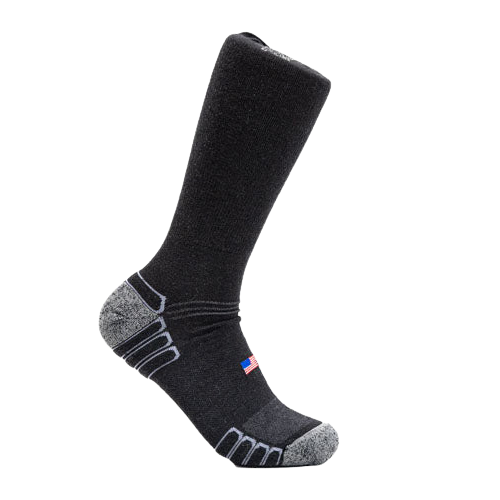A sock is a sock, right?
No.
You’ve worn a pair of socks before that just leaves your feet feeling swampy.
Well if you take that pair and hit the job site for 14 hours, do you know what you’re going to get?
Blisters, smelly feet, and all that moisture can even lead to moldy boots if you’re not careful. When I was designing our flagship product, the Camel City Mill Lightweight, I went through thousands of comments, did several interviews, and spent hours in the design lab to make a sock that would make blue collar workers feel like they had something made just for them.
So here’s the difference between a work sock and any old sock.
5 Purpose-Driven Reasons to Get a Work Sock
1. Material

Most socks are made with either cotton or polyester. And those materials suck when it comes to working long hours.
Merino wool is easily the most breathable and sweat wicking material you can get for your socks. Don’t let anyone tell you otherwise. It’s science.
Merino wool is 35% better at wicking sweat than polyester, and 25% better than cotton. And if you check nearly all of the major brands that are sold in gigantic retailers, you’ll notice that all the “sweat-wicking” socks are made primarily from synthetic fibers (i.e. polyester or nylon). Those are the worst fabrics to use.

So a lot of guys keep buying synthetic socks and think they have unnaturally sweaty feet, when the truth is that they keep being sold plastic bags to wear over their feet.

Even in the middle of summer, you want Merino wool on your feet. It keeps your feet from sweating, and because it’s so efficient at wicking sweat, it also cools your feet faster on hot days when you do perspire.
So if you’re getting a sock specifically for work, then you’ll want wool.
But sweat wicking isn’t the only benefit of Merino wool...
2. Durability

At Camel City Mill, we use a special type of Merino wool called Ironside Merino wool. We wanted to make a sock that we could guarantee for 10 years.
I’m not going to lie, my business partner thought the idea was crazy, but I liked the way it sounded and I was determined to find a material that could actually stand up to that promise.
Ironside Merino wool is basically the same as regular Merino wool, but we use a special loom that weaves the fibers in an unusual and structurally intricate way. This actually increases the durability of the wool without sacrificing any breathability.
You can see me picking up a heavy weight with a single thread of Ironside Merino wool here:

Insane, right?
Merino wool socks are more durable than cotton or polyester. I couldn’t tell you specifically why cotton and polyester are more weak-sauce compared to Merino wool, but I know that it drove me insane every time I put on my regular socks to find a hole in the big toe.
That just doesn’t happen with Merino wool socks.
Plus, if you shop with Camel City Mill, if you do get a hole in your socks, you can send them back to us and we’ll ship you a fresh pair (as long as the hole develops in the first 10 years of you owning them, which is a loooong time).
The best work socks use different thread to close the sock, too, and that’ll keep the toe seam from busting.
Obviously, you're putting your feet under a lot more pressure if you work a tough physical job. So you should get a sock that can keep up with the demands of that job.
3. Cushion

Work socks should have added cushion in the heel and the toe. If they don't, well, they’re not meant for work.
If the socks are made with something like Merino wool, then the thick padding shouldn’t add too much insulation to the point where your socks are uncomfortable.
For instance, even with the Camel City Mill Lightweight, we still add cushion in the heel and toe. In the heel, added padding helps with shock absorption. If you’re wearing steel toe boots, you absolutely need some padding in the front to help stave off the cold.
Composite toe boots are a little easier in terms of temperature regulation, but having some cushion in the toe still helps keep your big toe-nail from getting sore at the end of a 14 hour shift.
So you see? You could get a thin cotton sock and suffer through the rest of your life. Or you could shop with a brand like Camel City Mill, where we’ve thought of everything you’re going to face on the jobsite and made something specifically for you.
Most sock companies make a “boot sock.” But how many are thinking of the specific differences between a steel toe and a composite toe and designing a sock that can handle the rigors of each?
Just Camel City Mill, baby!
4. Compression
I grew up in the desert of Southern California. That place routinely lights on fire. So I was always very inspired by the wildland firefighters that would literally save the entire town that was in the hills right above where I lived.
I’m not exaggerating---we could walk into the canyon and see charred earth all the way right up to someone’s fence-line, and then it would look completely untouched.
I have no idea how they could pull that off.
Anyway, wildland firefighters go hog during the fire season and they’re usually putting in 16 hour days, and a lot of times they’re going 7-days a week. Every wildland firefighter has a story of pulling a shift that goes over 24 hours.
So with that in mind, I wanted to add some light compression to the Camel City Mill Lightweight sock. The compression helps improve circulation, which in turn keeps your feet feeling refreshed after long shifts.
With compression, your feet won’t feel as sore the next morning when you wake up, so you’ll be ready to tackle another heavy shift.
One added benefit of compression is that the socks actually stay up. If you regularly wear an 8” or 10” boot, you know how frustrating it is to try and fish your sock up from the inside of your boot ankle.
That’s something we wanted to avoid, and the compression element took care of that. So for linemen or loggers who wear 10” boots and even higher, you won’t lose your sock down around your ankle and you won’t feel the leather against your calf (which can get uncomfortable).
5. Venting

Lifting, walking, bending...everything you do during a work shift heats you up. You gotta have some way to vent out that heat.
You launch a ton of heat from your head. And what’s the second-most heat-emitting body part? That’s right---the feet.
Work socks often have special vents where the weave of the sock isn’t as closely knit to allow for greater breathability.
For Camel City Mill, we got an infrared scanner and analyzed exactly where the most heat is released from the foot (and while we were renting the unit, I also analyzed basically everything with the infrared scanner, like my dog, every object in my house, etc.).
It turns out, the majority of heat you release from your foot is in two spots: the bottom of your feet and the top of your foot right behind the first major knuckles of your toes.
So you already know what we did: we created a special vented pattern in our socks to allow for greater breathability specifically in those areas. And what’s awesome is that those are pretty low-impact areas for work boots (relative to the heel, toe, and the instep), so even though the weave is less tight, the sock overall maintains its durability.
And because those two areas aren’t responsible for keeping the sock up on your ankle, we increased the percentage of wool in those areas to allow for maximum sweat wicking.
I’m not one to toot my own horn, but beep beep...this sock design is literally completely genius.
Ditch the Basic Socks
It’s time to upgrade to work socks.
I’m biased---I think you should get the Camel City Mill Lightweight work sock because I know how much effort and science went into developing this particular sock specifically for workers.
But even if you decide on a different brand for your work socks, make sure they have the following 5 features:
- Merino wool. Don’t wear plastic bags on your feet (cotton is fine, I guess...but just don’t do polyester)
- Make sure they’re durable---the brand should back their work socks with a guarantee of some sort.
- Cushion. You’ll especially need cushion in the toe if you wear safety toe boots (steel or composite).
- Compression. The benefits here are two-fold: your socks actually stay up, and your feet will recover faster after a long day on the job.
- Venting. The best work socks will have special ventilation areas where your feet can launch extra heat. Merino wool does a great job keeping your feet cool, and vents help the wool do its job even better.
Get the Camel City Mill Lightweight now.






